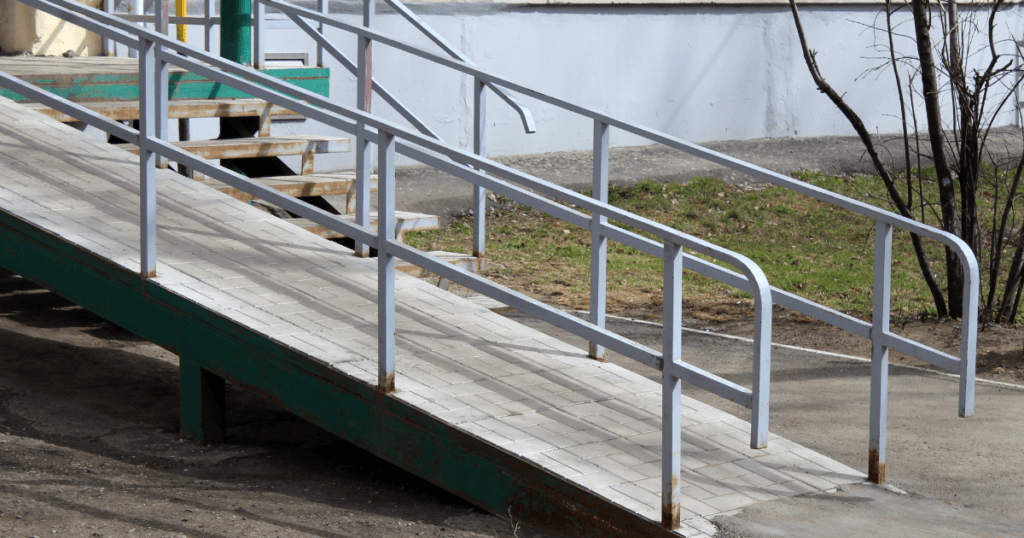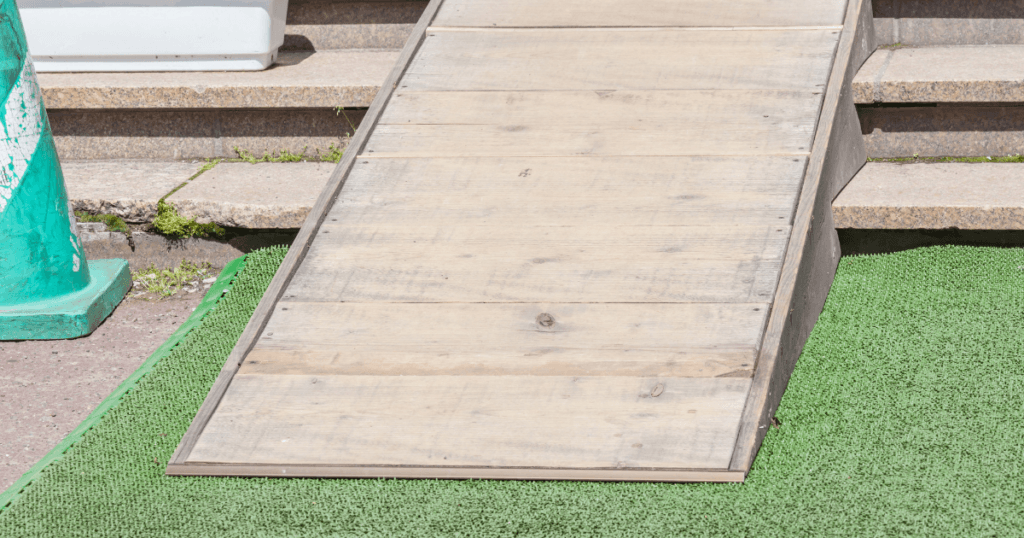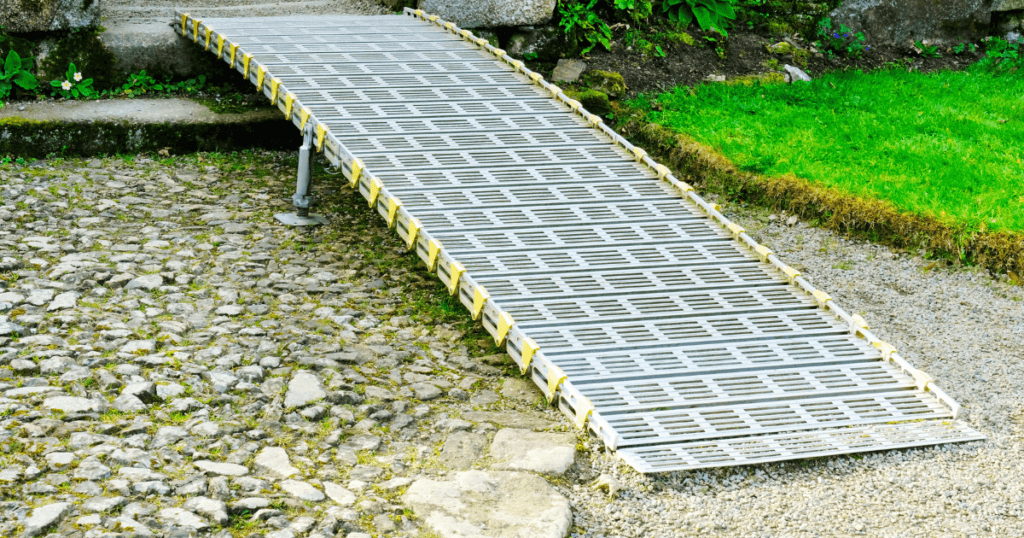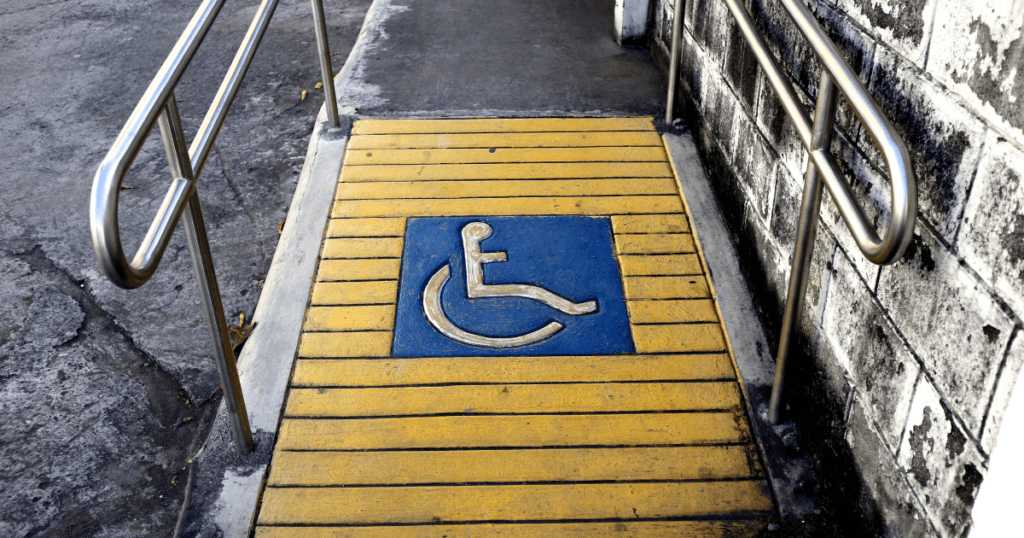Navigating life with mobility impairments can be challenging, especially when accessing different spaces. One of the most crucial elements that can make a world of difference is a wheelchair ramp. But the question that often arises is – what is the best material for a wheelchair ramp? With many options available, it can be daunting to make the right choice. This article delves into the strengths and weaknesses of popular materials like wood, aluminum, concrete, and steel, helping you decide on your needs.
Understanding Wheelchair Ramps
A wheelchair ramp is more than just a simple construction. It’s a vital tool that enhances mobility and provides accessibility for individuals who use wheelchairs, walkers, or other mobility aids. Its primary purpose is to facilitate a smooth and safe transition from one level to another, making spaces more accessible and inclusive. Whether bridging the gap from a sidewalk to a building entrance or providing access between different groups within a home, a wheelchair ramp can significantly improve the quality of life for individuals with mobility impairments.
When choosing a wheelchair ramp, several factors come into play. These considerations ensure that the ramp serves its purpose effectively and provides the best possible accessibility solution.
- Location: The placement of the ramp is crucial. It should be installed in a location that provides the most direct and convenient access to the building or space. The location also determines the length of the ramp, which should comply with local building codes and ADA guidelines.
- Weather Conditions: The local climate and weather conditions can impact the choice of material for the ramp. For instance, a non-slip material like aluminum or treated wood would be safer in areas prone to rain or snow.
- User Needs: The specific needs of the user are paramount. Consider the type of mobility aid used (wheelchair, walker, etc.), the user’s physical strength, and whether a caregiver will often accompany them. For instance, ramps with a gentler slope might be necessary for users who self-propel their wheelchairs.
- Budget: While it’s important to prioritize quality and safety, budget constraints often play a role in the decision-making process. The cost can vary significantly depending on the material, size, and whether the ramp is permanent or portable.
- Maintenance: Some materials require more upkeep than others. Wood, for example, may need regular sealing to prevent rot, while aluminum or steel ramps might be more durable and require less maintenance.
Understanding what a wheelchair ramp is and the factors to consider when choosing one is the first step toward enhancing accessibility. The key is to find a balance between functionality, safety, cost-effectiveness, and user-specific needs.

So What Are The Best Material For A Wheelchair Ramp? Let’s take A Look
Types of Wheelchair Ramp Materials
Wood
Pros: Wood ramps can be painted or stained to match a home’s exterior, making them attractive. They also provide a natural non-slip surface, which can be beneficial in wet weather conditions.
Wood is a traditional choice for wheelchair ramps due to its natural aesthetic and versatility.
Cons: Wood ramps require regular maintenance, including sealing, to prevent rot and damage from insects. They can also be more expensive and time-consuming to install compared to other materials.
Ideal Situations: Wood ramps are best suited for residential settings where aesthetics are prioritized, and regular maintenance is feasible.
Aluminum
Aluminum is a popular choice due to its strength and lightweight nature.
Pros: Aluminum ramps are durable, rust-resistant, and require little maintenance. They are also lightweight, making them easier to install and reposition if necessary.
Cons: Aluminum can become slippery when wet, so choosing a ramp with a non-slip surface is essential. They can also be more expensive than other options.
Ideal Situations: Aluminum ramps are ideal for areas with harsh weather conditions due to their durability and rust resistance. They’re also a good choice when portability is a priority.
Concrete
Concrete ramps are a more permanent and sturdy option.
Pros: Concrete ramps are extremely durable and can be customized to match the look of your home or business. They also provide excellent traction.
Cons: Concrete ramps are permanent and cannot be moved or adjusted easily. They require professional installation and can be more expensive than other options.
Ideal Situations: Concrete ramps are best for commercial buildings or homes where a permanent, low-maintenance solution is needed.
Steel
Steel is another durable and robust material option for wheelchair ramps.
Pros: Steel ramps are incredibly strong and durable. They can support a high weight capacity and resist wear and tear.
Cons: Steel ramps can be heavy, making them less portable. They can also rust if not properly treated or maintained.
Ideal Situations: Steel ramps are suitable for high-traffic areas or commercial settings where durability and strength are paramount.
In conclusion, each material has its unique set of advantages and disadvantages. The best choice depends on the user’s specific needs, the ramp’s location, and the local weather conditions.

Comparing Wheelchair Ramp Materials
When selecting the best material for a wheelchair ramp, comparing the options based on durability, cost, maintenance, and suitability for various situations is essential.
Durability: Steel and concrete ramps are typically the most robust options, capable of withstanding heavy use and harsh weather conditions. Aluminum is also durable and has the added benefit of being rust-resistant. Wood, while strong, requires regular maintenance to maintain its durability and can be susceptible to rot and insect damage.
Cost: The cost of wheelchair ramps can vary significantly depending on the material. While highly durable, concrete ramps are the most expensive due to materials and professional installation costs. Steel and aluminum ramps are generally less expensive than concrete but can still be a significant investment. Wood ramps can be cost-effective, especially if you can perform construction and maintenance.
Maintenance: Aluminum and steel ramps require the least maintenance, making them a convenient choice for many people. Concrete ramps also require minimal maintenance, but any repairs needed can be more complex and costly. Wood ramps require the most care, including regular sealing and protection from the elements.
Best Material For A Wheelchair Ramp For Different Situations: The best material for a wheelchair ramp largely depends on the specific situation and needs. For instance, concrete may be the best choice if you’re looking for a permanent, low-maintenance solution for a commercial building. If you need a ramp for a residential setting that blends with your home’s aesthetics, a wood ramp could be ideal. Aluminum is often the best material for a lightweight, portable, and durable ramp. And for high-traffic areas where strength and durability are paramount, steel ramps can be an excellent option.
There’s no one-size-fits-all answer to the best material for a wheelchair ramp. It’s about balancing durability, cost, maintenance, and the user’s specific needs and location. By comparing the different materials, you can make an informed decision that ensures accessibility, safety, and convenience.

Tips for Choosing the Best Material
Choosing the best material for a wheelchair ramp involves more than just comparing different materials. It requires thoughtful consideration of the user’s needs, the ramp’s location, the local climate, and your budget. Here are some practical tips to guide you in making the right choice:
Understand the User’s Needs: The user’s needs should be at the forefront of your decision. Consider the type of mobility aid used, the user’s physical strength, and whether they will use the ramp independently or with assistance. For instance, if the user self-propels their wheelchair, a ramp with a gentler slope and non-slip surface would be ideal.
Consider the Location: The ramp’s location can influence the choice of material. For instance, if the ramp will be exposed to harsh weather conditions, materials like aluminum or treated wood that can withstand these conditions would be a good choice.
Assess the Local Climate: The local climate plays a significant role in the choice of material. A non-slip material like aluminum or treated wood would be safer in areas prone to rain or snow. In contrast, in drier climates, you might have more flexibility in your choice of material.
Budget Accordingly: While it’s important to prioritize quality and safety, budget constraints often play a role in the decision-making process. Be sure to consider not only the initial cost of the ramp but also the long-term maintenance costs. For instance, while wood ramps might be less expensive initially, they may require more upkeep in the long run.
Seek Professional Advice: If unsure about the best material for your situation, consider consulting with a professional. They can provide valuable insights and recommendations based on their experience and expertise.
Choosing the best material for a wheelchair ramp is a decision that should be made carefully, considering various factors. By taking the time to understand your specific needs and circumstances, you can select a ramp that provides the best combination of functionality, safety, and value.

What is the cheapest material for a ramp?
The cheapest material for a ramp can vary based on several factors, including the size of the ramp and local material costs. However, wood is generally considered the most cost-effective material for building a ramp.
It’s widely available and less expensive than aluminum, steel, or concrete. However, it’s important to note that while the initial cost of a wooden ramp may be lower, it may require more maintenance over time, which could increase its overall cost. Always consider the upfront and long-term costs when choosing a material for a ramp.
More Ramp Stuff Here
- What Are The Best ADA Requirements For A Wheelchair Ramp
- The 5 Best Boat Boarding Ramps For Wheelchairs
- How Can I Get A Free Wheelchair Ramp?

Ramp It Up…
In the quest for the best material for a wheelchair ramp, the answer isn’t one-size-fits-all. It largely depends on your unique needs, location, and personal preferences. We hope this comprehensive guide has shed light on the various options available and their pros and cons. Whether you’re looking for a permanent or temporary solution, there’s a material out there that’s just right for you. If you have any further questions about wheelchair ramps or any other accessible home modifications, feel free to reach out. We’re here to help you navigate your way to a more accessible life.
